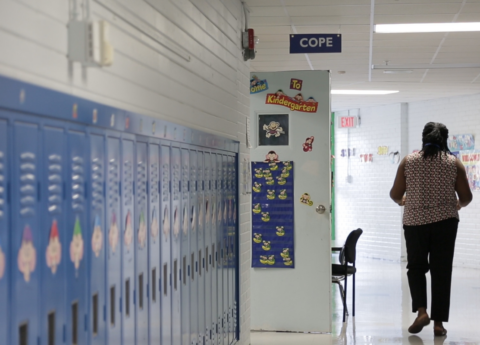Kentucky K-12 schools may be getting by with current levels of funding—which are among the nation’s deepest per-student cuts to education since the recession—but in order to realize the state’s goals, to graduate students college and career ready, additional investments are needed. Economically disadvantaged students in particular are falling behind, which is exacerbated by schools in poorer areas being less able to make up for state and federal budget cuts by raising local revenues. According to a new report by the Council for Better Education (CBE), “Adequacy for Excellence in Kentucky,” in order to reach the high academic achievement goals set out in 2009’s Senate Bill 1 Kentucky will need a funding system that better supports them.
The study evaluates how Kentucky is performing at its current level of funding—compared to national averages, comparison states and leading states—and then describes what, according to research, are elements of a comprehensive and high-quality instructional program. The full cost of implementing such a model is estimated to be about $2.4 billion more than is currently spent on K-12 education. The second part of the report, which provides detailed information on the model’s costs, will be made available by CBE at a later date.
How Kentucky compares to other states
In the report’s evaluation, Kentucky is performing relatively well considering its low levels of funding—although there are serious shortfalls, and the state is not where is aspires to be in terms of student achievement. The study compares Kentucky to seven other states with similar characteristics—Alabama, Arkansas, Indiana, Missouri, Ohio, Tennessee and West Virginia—as well as a set of high-performing states including Massachusetts and Minnesota.
Among the findings are that Kentucky is behind five of the comparison states and 31st in the nation in per-pupil funding. Adjusted for the cost of doing business in each state, Kentucky’s per-pupil spending is still below the national average, ranking 29th nationally.
The state’s pupil to classroom teacher ratio in 2012-13 was 15.8 to 1—just below the national average of 15.9 to 1—but Kentucky fell short in average teacher’s salary; at $50,326 it is $6,057 lower than the national average teacher salary and ranks Kentucky just 27th nationally on this measure. Adjusted for the difference in costs between states, Kentucky’s average teacher’s salary was $54,170 in 2012-13, which was $2,213 below the national average and ranks the state 26th nationally.
In terms of student achievement, National Assessment of Educational Progress (NAEP) exam scores in reading and math for 4th and 8th grades have been relatively flat since 2003, but the state’s students have scored above the national average in reading in both grades and in math in the 4th grade. The report points out that this is despite the state’s greater than average poverty rate. However, these NAEP numbers for Kentucky do not reflect the disparities in achievement for low-income students. Other data reported in the study show that students who are eligible for free and reduced price lunch in Kentucky are half as likely to have NAEP test results that are at or above proficient as students who are not eligible for this program (the four different student achievement levels are advanced, proficient, basic and below basic).
Also, while Kentucky’s NAEP test scores are above the national average in most areas (but not in 8th grade math), the report points out that the picture is not as rosy if we compare ourselves to the high-achieving states, whose students consistently finish at the top on national exams. Kentucky’s graduation rates are also significantly lower than those states. And high-achieving states (other than Kansas) also spend between 15.9 percent and 96.6 percent more than Kentucky per pupil on their schools.
What the research says about adequacy
After laying out where Kentucky is in terms of funding and academic achievement, the “Adequacy for Excellence in Kentucky” report describes what an “Evidence-Based” (EB) approach to adequacy would look like in Kentucky. The EB model details “a cohesive set of school-level resources, or elements, required to deliver a comprehensive and high-quality instructional program and describes the evidence on programmatic effectiveness,” based on a review of rigorous research evidence. Adequate funding is then the amount of money it would cost to realize the model in Kentucky each year—approximately $2.4 billion more than the state currently expends on K-12 education if the full model were adopted. Among the elements of the proposed funding model are:
- Full-day preschool available to all 3 and 4 year-olds, with primary access given to children from families with an income at or below 200 percent of the poverty level. Currently half-day public preschool in Kentucky is offered with no charge only to children with disabilities at age three or four—or from families at or below 150 percent of poverty at age four (this changes to 160 percent of poverty in 2015-2016). As we’ve noted elsewhere research shows that high- quality preschool education can have important long-term impacts, especially for students from disadvantaged backgrounds. According to the report, “Students from lower income backgrounds who experience a high quality, full-day preschool program gain more basic skills in elementary school, score higher on academic goals in middle and high school, attend college at a greater rate, and as adults, earn higher incomes and engage in less socially-undesirable behavior. There is a return over time of eight to ten dollars for every one dollar invested in high quality preschool programs.”
- Full-day Kindergarten for all public school students. Currently in Kentucky only some programs are full-day. Research suggests that full-day Kindergarten has significant, positive effects on student learning in the early elementary grades, particularly for students from low-income backgrounds.
- 15 to 1 student-teacher ratios for grades K through 3 and 25 to 1 for grades 4 through 12 for core content teachers. The state’s current funding formula (known as SEEK) does not have a target for a student to teacher ratio. Research shows smaller class sizes are associated with higher achievement, and the impact is even larger for low-income and minority students.
- One fully licensed teacher-tutor position in every school, and one fully licensed teacher-tutor position for every 125 pupils eligible for free and reduced price lunch. According to the report, research shows that one-to-one tutoring by licensed teachers is the most powerful and effective extra help strategy to enable struggling students to meet state standards; students who need more assistance to achieve proficiency levels (for instance, those with Limited English Proficiency, are low-income or have minor disabilities) especially benefit from tutoring.
- Extended-day classes of 15 students for two hours a day five days a week. Research shows that extended-day programs can produce positive academic outcomes for students, particularly if they are low-income.
Other important elements of the EB model are: relatively small schools (450 student K-5 elementary schools, 450 student 6-8 middle schools and 600 student 9-12 high schools); summer school offerings based on the number of free and reduced price lunch program students; the provision of one instructional coach position for every 200 students; expanded professional development opportunities; and specific allocations per student for technology and equipment, library texts and electronic services, and textbooks and related materials.
According to the CBE report, Kentucky’s current K-12 funding system—and funding levels—may enable the state to continue making some progress in academic achievement. But to get where the state wants to be, particularly in reducing achievement gaps for low-income students, new resources should be considered. The evidence-based model and its elements—for instance, universal full-day preschool and expanded student supports such as tutoring and extended-day programs—provide ideas for how added resources could be used effectively to improve student success.



